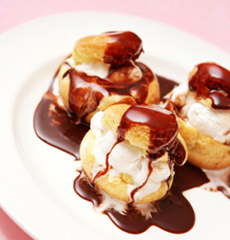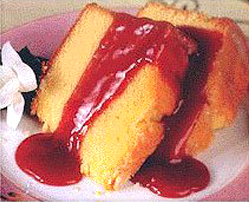CakeDessert Sauces & Toppings Glossary: A Glossary Of The Different Dessert Sauces & Toppings TypesPage 1: Dessert Sauces & Toppings Glossary A To G This is Page 1 of an 8-page article. Click on the red links below to visit other pages. This glossary is protected by copyright and cannot be reproduced in whole or part. You are welcome to link to it.
|
 One of mankind’s favorite places to pour chocolate sauce is on top of ice cream-stuffed pâte à choux. The dish, known as profiteroles, is a name said to derive from profit, a French word meaning small gift, which is indeed what it is. Photo by Kevin Russ | IST. |
|
| Caramel Sauce Caramel sauce is made from the same ingredients as caramel candy. The best recipes are simply cream, butter, sugar and flavoring such as vanilla, although cayenne, coffee, maple, and a broad variety of flavors can be used. Salt can be added to make salted caramel sauce; chocolate can be added to make chocolate caramel. At room temperature, a good sauce will be almost as thick as caramel candy, and can be eaten from the jar as “spoon candy.” It is heated to become pourable.
|
||
| Caramel Syrup Caramel syrup is a clear, golden-colored sugar syrup that omits the cream and butter found in caramel candy and caramel sauce. The sugar is caramelized at high heat, making it look and taste different from a simple sugar syrup. It’s easy to make and is used as a dessert syrup on ice cream, cake, pie and pudding. It is also added to beverages, and has found new fans mixed into coffee for a caramel macchiato.
|
||
| Chocolate Sauce or Syrup See fudge sauce.
|
||
| Chocolate Syrup See syrup.
|
||
| Coulis French for “strained liquid,” coulis is a sauce made from puréed and strained fruit or vegetables (strawberries, raspberries, and tomatoes are most commonly used). A coulis (pronounced coo-LEE) is often served over breakfast items, such as pancakes, crêpes and waffles or pancakes, or over dessert items, such as ice cream, cheesecake and soufflés. The term became popular during the ascent of nouvelle cuisine that in the 1980s, when newer items such as basil, mint and tomato coulis were appearing on plates, to make the preparations seem different and even more exciting than a traditional purée. To split hairs, in a coulis the liquid has been strained, removing any seeds or fiber. A purée is not necessarily strained, although professional chefs would be trained to strain their purées. Crème Anglaise
|
||
| Custard Sauce A thinner version of crème anglaise. See more types of custard in our Custard Glossary.
|
||
| Curd Curd is a type of creamy, fruit-based spread made of fruit juice, butter, eggs and sugar. Citrus and berry flavors are the most popular. Curd is more versatile than fruit butter, and can be used on angel cake, ice cream, pancakes, pound cake and other desserts, as well as on breads. Raspberry curd on lemon pound cake. Curd by Rowena.
|
 |
|
| Fudge Sauce A chocolate sauce made of cream, butter, chocolate. In theory, fudge sauces are thicker than chocolate sauces, but there is no industry standard definition—it’s what the manufacture chooses to call it. Some fudge sauce recipes include cocoa powder as well as chocolate. Some chocolate sauces are thicker and more chocolatey than those labeled “fudge sauce.” “Hot fudge” sauce is simply the sauce heated up. When fudge sauce or chocolate sauce is heated, it becomes thinner. When at room temperature in the jar, they are as thick as fudge candy, and can be eaten with a spoon like candy—hence the name. |
||
| Fruit Butter A variation of a spread that can contain chunks of whole fruits: apple and pumpkin are popular flavors. It is commonly used instead of jam on breakfast breads and does not contain any butter—the term refers to the consistency. |
||
Last Updated May 2018
© Copyright 2005-2025 Lifestyle Direct, Inc. All rights reserved. All images are copyrighted to their respective owners.